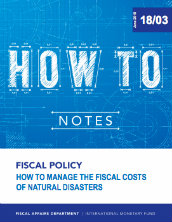How to manage the fiscal costs of natural disasters
 This how-to note focuses on the management of the fiscal costs associated with natural disaster risks. Unlike other types of fiscal risks (for example, unexpected macroeconomic changes or materialization of contingent liabilities), a natural disaster presents a unique challenge to fiscal risk-management and budget processes because of its exogenous nature and potentially overwhelming scale. This note discusses how governments can build fiscal resilience against natural hazards and strengthen fiscal management after a disaster, including through budgeting frameworks and other fiscal policies. The note aims to answer three central questions: How large should fiscal buffers be? How should fiscal buffers be built up? How should fiscal buffers be used efficiently and transparently once a natural disaster has struck? These three questions directly relate to fiscal policy, fiscal risk management, and the budget process—all core areas of IMF expertise. To address them, the note focuses on fiscal strategies for financing recovery efforts and considers approaches to mitigate disaster impact.
This how-to note focuses on the management of the fiscal costs associated with natural disaster risks. Unlike other types of fiscal risks (for example, unexpected macroeconomic changes or materialization of contingent liabilities), a natural disaster presents a unique challenge to fiscal risk-management and budget processes because of its exogenous nature and potentially overwhelming scale. This note discusses how governments can build fiscal resilience against natural hazards and strengthen fiscal management after a disaster, including through budgeting frameworks and other fiscal policies. The note aims to answer three central questions: How large should fiscal buffers be? How should fiscal buffers be built up? How should fiscal buffers be used efficiently and transparently once a natural disaster has struck? These three questions directly relate to fiscal policy, fiscal risk management, and the budget process—all core areas of IMF expertise. To address them, the note focuses on fiscal strategies for financing recovery efforts and considers approaches to mitigate disaster impact.
Related Content
- Fiscal resilience to natural disasters: lessons from country experiences
- Enhancing macroeconomic resilience to natural disasters and climate change in the small states of the Pacific
- Bangladesh State of Environment Report: The Monthly Overview, April 2014
- Bangladesh State of Environment Report: The Monthly Overview, March, 2014
- Monthly Overview on State of Environment, Nepal, January 2014
